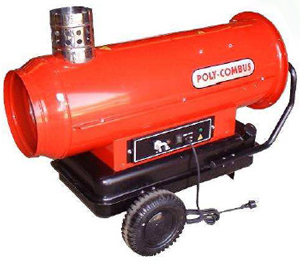SPACE HEATER mobile, 37 kW, 230V, diesel
Outdated Article
SPACE HEATER
Definition
Forced-air heating device, intended for large spaces, such as stores, community rooms, tents.
Specifications
- Diesel burner
- Electric fan
- Heating capacity (1 kW = 860 kcal/h):
- CCLIHEATS3- = 31820 kcal/h = 37 kW
- CCLIHEATS5- = 45580 kcal/h = 53 kW
- CCLIHEATS8- = 722400 kcal/h = 84 kW
- Diesel consumption:
- CCLIHEATS3- = 3.35 litre/hr
- CCLIHEATS5- = 4.84 litre/hr
- CCLIHEATS8- = 7.72 litre/hr
- Tank capacity:
- CCLIHEATS3- = 51 litre
- CCLIHEATS5- = 51 litre
- CCLIHEATS8- = 100 litre
- Airflow:
- CCLIHEATS3- = 2000 m3/hr
- CCLIHEATS5- = 2500 m3/hr
- CCLIHEATS8- = 4500 m3/hr
- Power requirement:
- CCLIHEATS3- = 460 W
- CCLIHEATS5- = 460 W
- CCLIHEATS8- = 800 W
- Options:
- outlet cone
- hot air duct
- Y connection for 2 ducts
- weatherproofing
- fuel preheater
- flue
- thermostatic regulator
Calculation of the required output
For a quick calculation of the required output of a space heater, use the following formula:
P = ΔT x V x K / 8600 |
| P | power of the space heater, in kW (1 kW = 860 kcal/h) |
| ΔT | difference between external temperature and desired internal temperature, in ºC |
| V | volume of the space, in m3 |
| K* | coefficient of thermal conductivity |
*Nature of insulating material | K |
Well insulated brick or breezeblock walls Glass fibre or polystyrene Insulated roof or false ceiling | 1,2 |
Uninsulated brick or breezeblock walls Insulated roof or false ceiling Moderately insulated room | 2,4 |
Uninsulated brick or breezeblock walls Uninsulated roof Badly insulated room | 3,5 |
Wooden or sheet metal walls Sheet metal or fibre cement roof Uninsulated room | 4 |
Tent | 27 |
Instructions for use
There are two options:
- either the heater is placed outside the space and warms cold outdoor air, then blows it inside through a duct
- => less efficient
- => air is changed
- or the heater is placed inside the space and directly warms the indoor air, while a pipe takes the exhaust gases outside
- => more efficient
- => air is not changed.
Always ensure that the room is well ventilated, or else remove the exhaust gases.
The fuel used should be of the same quality as that used for vehicles.
Good heat insulation is the first solution to heating problems.

